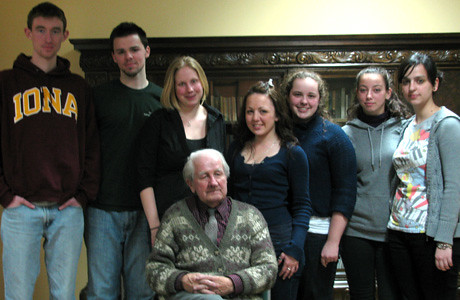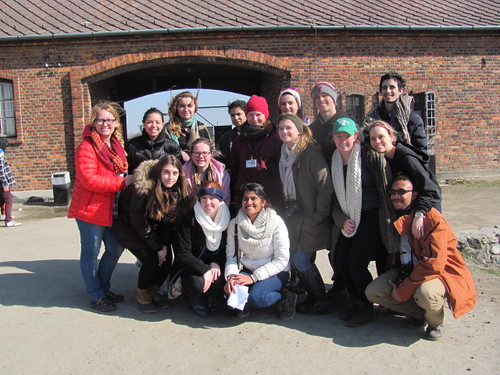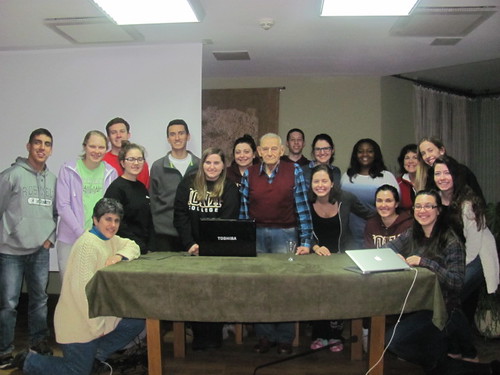 |
| A rose left on the bunk of a wooden barrack at Auschwitz Birkenau. |
 |
| A calligraphy/hand-lettered piece on Hope. |
Similar to my last blog post, I begin with an Anne Frank quote. In contrast, this post is about hope, as opposed to hopelessness. To me, this quote displays hope in humanity, regardless of how horrifically Frank’s family and other Jewish families were treated throughout the Shoah.
This week has taught me so much about history. On top of that, it has taught me a lot about myself, especially the way I process things. Whether positive or negative, exciting or boring, I like to reflect on life experiences through calligraphy and hand-lettering. Calligraphy, which has been around for thousands of years, has evolved on social media to “hand-lettering” by millennials. Hand-lettering is a way of creating various fonts, alongside calligraphy to express words. Over the last decade, I have found myself taking profound concepts and minimizing them to handwritten fonts to express myself. It is therapeutic for me and can make for great gifts and cards!
I decided to center the entire piece around hope. Before creating it, I read through “Celebrating and Deepening the New Christian-Jewish Relationship”. The natural optimist in me loved this, as hope is a common theme throughout it all. This statement was sent out for the Golden Jubilee of the Second Vatican Council Declaration, Noestra Aetate. Within the introduction, there is a positive undertone that guided my thought process. “Like people dreaming of what were once unimaginable possibilities (Psalm 126:1) we look forward to a future full of hope” (pp. 44). Written by the ICCJ for a conference in Rome in 2015, this statement reviews the new, positive dialogue between Christians and Jews since the Shoah. It begins with the distance made from the awful starting point that allowed millions of Jewish people to be persecuted and killed. Christianity played a role in allowing this to happen, through the Teaching of Contempt. Jewish people were made out to be “Christ-killers” by many Christians in the early 1900s and this negative connotation brought about indifference, which led to the genocide. The council states that today “we have been learning to speak to each one another as friends and companions…for the first time in history Jews and Christians can work and study together in a sustained way, thereby enriching each other’s covenantal lives” (pp. 45). I was able to see this first hand multiple times, and I am thankful I was able to express this in hand lettering.
First, (the top left corner reads) “Saint Maximillian Kolbe, pray for us”. I added this when I saw it left in the room he was kept in during his starvation period. He was an example of hope for me this week because he gave of his life for another, which is the greatest form of love. Amongst hate, I was reminded that people are also good.
Second, (the top right quote) says, “life makes sense as long as you save people”. This quote, by Oscar Schindler was painted on the wall of Schindler’s Factory, which we visited in Krakow on Wednesday. Schindler saved over 2,000 Jewish people by hiring them in his factory so they would not be sent away to ghettos and concentration camps. He was courageous, and the face of hope in a very tense time.
Third, (the words directly below) that read “Shabbat Shalom”, and were said during the Shabbat dinner we ate on Friday night with the Jewish community in Krakow. The entire community brought me so much hope for peace in the world today, because they invited people of all ages, backgrounds, and religions into their center to enjoy a meal with them. Their hospitality, despite barely knowing us, brought me encouragement and taught me the significance of recognizing dignity in all people.
Fourth, (to the left of the prior quote) is from Simon Peereboom. “We still believed it would all be alright”. This quote was on the wall in one of the blocks at Auschwitz I. It stood out to me when we returned Thursday, because Peereboom displayed so much hope in his future, regardless of how anxious the present seemed.
Fifth, (to the left of Peereboom’s) is a John Lennon quote from his song “Imagine”. Written on a stone outside Auschwitz Birkenau, it says, “imagine all the people, living in peace”. Although I had known this song before coming to Poland, it struck a chord with me before entering the “Gate of Death” because it was a display of hope for a more peaceful future in the world, but left by an anonymous stranger. It left me with the comforting thought that our group was not alone in being advocates of peace, that there are many others out there, too.
Sixth, (above Lennon’s quote) is a verse. “And in your book they all will be written” (Psalm 139:16). This was written in front of the Book of Names at Auschwitz I, which documented the names of the victims of the Shoah. As I walked around the largest book I’d ever seen in my life, I felt hopeless. But, when I saw this verse I felt comfort and hope that this memorial was summarized with a verse that reflected back on a Creator, one who is loving and keeps the names of His people, even if humans replace those names with numbers.
Finally, I end with the quote that started this blog. “Despite everything, I still believe people are good at heart” (Anne Frank). After hearing this quote, I eagerly picked up her book in one of the bookstores and I began it. Although I am only 40 pages in so far, I can see how she displayed humor and an uplifting outlook, even though her world was rapidly declining.
This theme of hope will stick with me forever when I recount this trip to others. I am confident that I will be able to reference all of these quotes, as well my Catholic faith through documents like Nostra Aetate and the more recent ones to remain hopeful in humanity and be a voice for the voiceless.





















